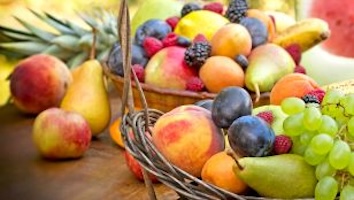Lesson 1 - Understanding fruits

A fruit is defined botanically as a reproductive structure that develops from the ovary of a flower following fertilisation. Fruits help protect and disperse the seeds that are enclosed within in. They can have appendages or coatings that assist with distribution and germination, or consist of a sweet and fleshy exterior, enabling the fruit to be consumed, aiding dispersal. Classifying fruits is based firstly on whether the fruit is fleshy or dry, and then its development and structure. Simple fruits develop from a flower with a single ovary (e.g. cherry, grape), aggregate fruits arise from a single flower that has many ovaries (e.g. blackberry, raspberry), multiple fruits come from a multitude of flowers (inflorescence) that become fused together (e.g. pineapples, mulberries) and accessory fruits develop from parts that are separate to the flower (e.g. strawberry, fig). This means that botanically speaking, many common vegetables we eat, such as pumpkins, tomatoes and cucumbers, are fruits. However, when we talk about fruits in a common or culinary way we are generally talking about edible plant parts that are sweet, not savory as with vegetables.
From these main fruit types there are five main categories of soft fruits. The first of these are drupes, fruits with a large, central seed, often referred to as a pip, surrounded by sweet, juicy flesh, examples include cherries, plums, olives and peaches. Then there are pomes, fleshy fruits with many seeds arranged in the centre of the fruit, called cores, apples, pears and quinces are the best examples. A berry is a thin-skinned fruit with several seeds and sweet flesh, but lacks a pip or core, such as grapes, bananas and tomatoes. Modern varieties of many berries have been bred without any seeds. A fruit like a berry but with a thick, sometimes tough, skin surrounding segmented flesh and occasional seeds are called hesperidium, such as citrus, including lemons, limes and oranges. And finally, another relative of berries is the pepo, such as pumpkins, gourds, squash and melons, which has a thick skin or rind and a watery and fleshy interior.
Another way to categorise fruits is based on where they grow climatically. Tropical and subtropical fruits grow in warmer climates, while temperate fruits grow in cooler, climates that have distinctly four seasons. We can also categorise fruits based on their growth habit and lifecycle, including trees, bushes or shrubs, canes, vines (climbing plants) and even herbaceous plants such as strawberries.
Further learning
Further learning
- Australian Fruit and Vegetable Gardening by Clive Blazey and Jane Varkulevicius
- Backyard fruit - Gardening Australia
- Complete Book of Fruit in Australia: the definitive sourcebook for growing, harvesting and cooking by Bob Flowerdew (Simon &Schuster, 2018)
- The Complete Book of Fruit Growing in Australia by Louis Glowinski (Hachette Australia, 2008)
- Organic Fruit Growing by Annette McFarlane (ABC Books, 2011)
- Tropical Food Gardens: A guide to growing fruit, herbs and vegetables organically in Australia by Leonie Norrington (Bloomings Books, 2011)